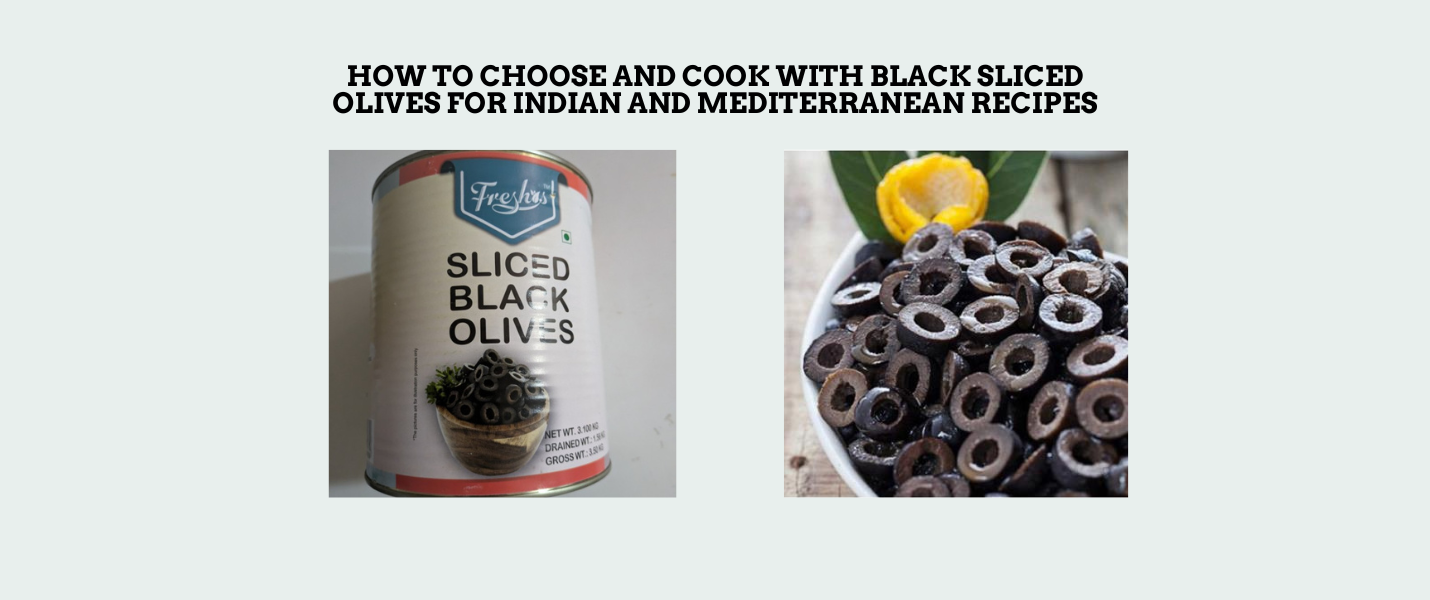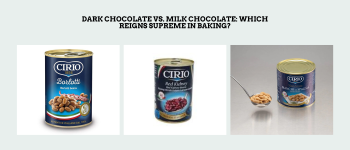

How to Choose and Cook with Black Sliced Olives for Indian and Mediterranean Recipes
Table of Contents
Introduction: The Olive’s New Place in Indian Kitchens
Understanding Black Olives: Varieties, Nutrition, and Health
2.1. What Are Black Olives?
2.2. Popular Black Olive Varieties
2.3. The Difference Between Green and Black Olives
2.4. Nutrition Facts and Health Value
2.5. Additional Benefits of Black Olives
2.6. Black Olives in the Indian Diet—A Nutritional Perspective
How to Choose the Best Black Olives for Home Use
3.1. Signs of Freshness & Quality
3.2. Brined vs. Oil-Cured vs. Canned/Jarred Olives
3.3. How to Read an Olive Label
Storage, Freshness, and Best Practices
4.1. How to Store Olives Once Opened
4.2. Handling Large Packs and Freezing
4.3. Managing Salt Content
Cooking With Black Olives in Indian Dishes
5.1. Why Olives Work in Indian Cuisine
5.2. Classic and Fusion Applications
- Salads & Chaats
- Toasts, Parathas & Stuffed Breads
- Upma, Pulao, and Mixed Rice
- Chutneys & Dips
- Curries & Menaskai
Health Benefits and Indian Nutrition Context
6.1. Fit for Modern Indian Diets
6.2. Benefits for Women
6.3. Suitable for Vegetarian, Vegan, and Satvik Diets
Black Olives in Modern Indian Food Culture
7.1. Rise of Global Flavors
7.2. Health Consciousness and Smart Snacking
7.3. Market Trends and Chefspoint Insights
Time to Embrace Olives in Every Indian Kitchen
Frequently Asked Questions (FAQs)
9.1. How do you store opened olives?
9.2. Are canned olives healthy?
9.3. Can black olives be used in traditional Indian curries?
9.4. Which olive types are best for salads?
9.5. What are some top olive recipes for beginners?
9.6. Are black sliced olives vegan and gluten-free?
9.7. How can you reduce the saltiness of olives for Indian dishes?
9.8. What nutritional benefits do black olives offer?
9.9. Can olives be used as a topping for Indian snacks?
9.10. How long do black sliced olives last after opening?
1. Introduction: The Olive’s New Place in Indian Kitchens
It’s a weekday evening in any major Indian city. The aroma of sabzi simmers in one kitchen; on another stovetop, rice is bubbling. Yet on an open countertop sits a jar of glossy Black Sliced Olives, wait, olives? Yes! Once the domain of Mediterranean salads and European deli counters, these savory little gems have become familiar faces in Indian kitchens. Whether you sprinkle them over home-style pizza, stir them into a tangy chutney, or even mix them with a classic pulao, black olives are now a beloved pantry staple.
The modern Indian kitchen is more adventurous than ever before. Global ingredients like black olives—especially pre-sliced, high-quality versions—are being welcomed alongside our traditional staples. Why? They offer a unique mix of health, convenience, and flavor. This in-depth blog will show you how to choose, store, and cook with black sliced olives, grounded in real data and the Indian culinary context.
2. Understanding Black Olives: Varieties, Nutrition, and Health
What Are Black Olives?
To get the most from any ingredient, know it well. Black olives are fully ripened olive fruits. As they mature on the tree, their color deepens from green to black, providing a milder flavor and softer texture. In contrast, green olives are harvested earlier, making them firmer and more bitter.
Popular Black Olive Varieties
- Kalamata: Almond-shaped, with a deep purple-ish black color, and a rich, tangy, complex flavor.
- Moroccan Dry-Cured: Wrinkled, intensely flavorful, and slightly smoky due to the drying process.
- Oil-Cured: Glossy, gently wrinkled, and known for their supple texture.
- Jarred & Canned (Freshos Black Sliced Olives from Chefspoint): Soft, mild, already pitted and sliced, perfect for quick everyday recipes.
The Difference Between Green and Black Olives
Green and black olives may come from the same tree, but their characteristics shift dramatically based on when they’re picked and how they’re processed. Understanding these differences helps home cooks and foodies select the right olive for every recipe, whether it’s a classic Indian fusion salad or a Mediterranean mezze. Here’s a simple table summarizing the main contrasts:
| Attribute | Green Olives | Black Olives |
|---|---|---|
| Harvest Time | Unripe (picked early) | Ripened (picked when fully mature) |
| Texture | Firm and taut | Softer and more yielding |
| Flavor | Tangy, sharper, slightly bitter | Mellow, earthy, less astringent |
| Common Use | Pickles, martinis, some salads | Cooked dishes, salads, breads, fusion foods |
Black Olives: Nutrition Facts and Health Value
Let’s break down the main nutrition stats of black olives (all values per 100g, sliced):
- Calories: ~115-150 kcal
- Protein: 1.0–1.5g
- Carbohydrates: 6g (mainly fiber, very little sugar)
- Fat: 10–15g (90% heart-healthy monounsaturated fat)
- Fiber: 3g
- Iron: 3.5mg (aids in energy and immunity)
- Sodium: 800–1200mg (varies with curing and brine)
- Vitamins: E, A, K
- Antioxidants: Polyphenols, flavonoids
- Key micronutrients: Copper, calcium
Benefits of Black Olives for Females
The iron, vitamin E, and healthy fats in olives are known to support skin health, hormone balance, and robust energy—particularly valued in women’s and adolescent girls’ diets. The vitamin E and polyphenols protect against cell damage and premature aging.
Additional Benefits of Black Olives:
- Heart Health: The monounsaturated fats (oleic acid) found in olives can help lower bad cholesterol (LDL) while raising good cholesterol (HDL), reducing the risk of heart disease.
- Bone Strength: Olives contain key minerals like calcium and copper, which are essential for maintaining bone density and preventing osteoporosis, especially important for women as they age.
- Anti-Inflammatory Properties: The presence of polyphenols and oleocanthal provides natural anti-inflammatory effects, soothing joint pain and supporting overall wellness.
- Weight Management: High in fiber but low in calories, black olives help increase satiety, control cravings, and support healthy weight goals.
- Digestive Health: Dietary fiber aids in regular bowel movements, supports gut microbiota, and may help prevent constipation.
- Immune System Support: The antioxidants in olives, including vitamin A and E, strengthen the immune response and help the body ward off infections.
- Blood Sugar Control: The fiber and healthy fats slow the absorption of sugar, helping to stabilize blood glucose levels—excellent for individuals managing diabetes or metabolic syndrome.
- Eye Health: Vitamin A in olives contributes to good vision and helps protect against age-related eye disorders.
Black Olives in the Indian Diet—A Nutritional Perspective
Why are so many doctors and nutritionists recommending black olives?
- Oleic acid (main fat) helps reduce bad cholesterol and supports heart function—important with urban workdays, sedentary lifestyles, and family health in mind.
- Rich fiber content supports healthy digestion, blood sugar balance, and long-lasting satiety.
- Individuals on vegetarian or Mediterranean diets benefit from the unique taste and nutrition olives bring.
3. How to Choose the Best Black Olives for Home Use
Selecting quality black olives for your kitchen can transform the flavor, nutrition, and enjoyment of both Indian and fusion dishes. Here’s a straightforward guide to help you shop wisely and make the best choice:
Look for These Signs of Freshness & Quality
- Smooth, Unbroken Skins: Avoid wrinkled or slimy olives unless they're a dry-cured style.
- Consistent Color: Uniform deep brown or black; avoid olives with large pale, green, or yellow patches (which can mean poor curing or age).
- Aroma: Should smell pleasantly fruity, never pungent or sour.
- Taste Test: Briny, slightly bitter, with a clean, olive oil aftertaste—never metallic or overly sharp.
Brined vs. Oil-Cured vs. Canned/Jarred Olives
When shopping for black olives, you’ll come across these three main types—each with its own texture, flavor, and best uses. Understanding the differences helps you pick the right olive for your recipe or snack.
- Brined/Oil-cured: These have classic olive character, intense flavor, and often need rinsing before use.
- Canned/Jarred (e.g., Black Sliced Olives by Freshos from Chefspoint): Mild, versatile, convenient, evenly sliced, ready for chutneys, curries, or salads.
How to Read an Olive Label
- Ingredients: Should be just olives, water, salt, and maybe a little citric or lactic acid.
- Avoid: Artificial colorings (like ferrous gluconate) and excessive sodium (>1300mg/100g), unless needed for storage.
- Shelf Life: Pick products with a clear manufacturing and expiry date.
- Origin: Olives sourced from Spain, Greece, or India’s Rajasthan are high quality.
4. Storage, Freshness, and Best Practices
How to Store Olives Once Opened
- Always keep olives submerged in their brine to maintain texture and prevent spoilage.
- Store in a glass or food-grade plastic container with a tight lid.
- Refrigerate immediately after opening; use within 7–10 days for the best taste and safety.
- If buying large bulk packs (like 3kg jars), divide into smaller portions and freeze what you won’t use in 7 days.
Pro Tip: If the olives dry out in the fridge, add a splash of olive oil to the brine—they’ll plump back up and stay glossy!
Don’t Ignore the Salt
Salt is necessary for both preservation and flavor. However, if you’re on a low-sodium diet, soak or rinse olives for a few minutes before use to cut the saltiness without losing essential flavor.
5. Cooking With Black Olives in Indian Dishes
Why Olives Work Beautifully in Indian Cuisine
- Their depth and earthiness play well with cumin, coriander, garam masala, and even south Indian tempering.
- They balance the richness of paneer, the mild sweetness of carrots or beets, and the sharpness of raw onions.
- Their healthy fats absorb and amplify spice flavors without becoming greasy, unlike some other fat sources.
Classic and Fusion Applications
Salads & Chaats:
- Add black sliced olives to classic kachumber (onion, cucumber, tomato), corn salad, or moong sprout chaat for a sweet-tangy lift.
- Boiled potatoes, green chutney, and olives give you a minimal-ingredient, high-fiber chaat perfect for summer lunches.
Toasts, Parathas & Stuffed Breads:
- Sprinkle well-drained black slices onto cheese paratha as a filling. Try with a blend of grated paneer, sautéed onions, and finely chopped olives.
- Cheesy olive toast: butter your bread, add cubed paneer, black olives, green chillies, and some chaat masala—grill or bake until golden.
Upma, Pulao, and Mixed Rice:
- Toss a handful of black sliced olives into the final step of vegetable upma or lemon rice.
- For Mediterranean-inspired pulao, add black olives, sautéed garlic, and cubed vegetables along with mint and coriander.
Chutneys & Dips:
- Blitz black olives with mint, coriander, lemon juice, and a green chili for a chutney that goes with dosas or samosas.
- Try your hand at black olive hummus for dippable, masala-friendly flavor (recipe below).
Curries & Menaskai (Karnataka-Style Sweet-Sour Curry):
- The umami of olives pairs exceptionally well with the sweet, tangy coconut base of South Indian curries.
- Add black olives at the end of cooking for the best flavor and appearance.
6. Health Benefits and Indian Nutrition Context
Black olives are one of nature’s simplest whole foods:
- They’re plant-based, so they fit vegetarian, vegan, and satvik (sans onion/garlic) diets.
- Their monounsaturated fats are scientifically linked to heart health, stable blood sugar, and optimal cholesterol.
Fun fact:
Women, especially those of reproductive age, can benefit from the iron and vitamin E in black olives—these nutrients strengthen hair, improve skin texture, and ward off iron deficiency.
In a balanced Indian diet:
- Use black olives as a protein partner with dals and paneer.
- Add to brown rice, bajra roti, or millet khichdi for a filling, low-GI plate.
- They’re naturally gluten-free, dairy-free, and nut-free.
7. Black Olives in Modern Indian Food Culture
Walk into an urban grocery today, and you’ll see two clear trends:
- The Growing Demand for Global Flavors: New generations are bringing home not just Italian snacks but bolder staples like olives, sun-dried tomatoes, and feta to mix with Indian dishes.
- Health Consciousness: Families are swapping deep-fried snacks for roasted or brined options, with olives and olive-based dips quickly climbing the popularity charts.
Market Data Point:
India’s retail sales of olives (black and green) grew more than 35% from 2018-2023, and social media “fusion” recipes—think, olive-topped chaat or dal toast—are continuing to trend.
Chefspoint Insight:
Shoppers are keen on value packs of black sliced olives—like the 3kg Freshos pack—for flexibility and economy, storing a big jar in the fridge and using it bit by bit.
8. Time to Embrace Olives in Every Indian Kitchen
From quick snacks to wholesome meals, Black Sliced Olives bring a world of flavor, nutrition, and global flair straight to your Indian kitchen. They pair with our favorite everyday staples—paneer, dals, rice, root vegetables—and modernize classic recipes with a single scoop. Beneficial for heart and gut health, a source of healthy fats and micronutrients, black olives are truly a new-age superfood our kitchens deserve.
Frequently Asked Questions
How do you store opened olives?
Keep black sliced olives completely submerged in their brine, sealed in an airtight container, and always refrigerated. Proper storage this way keeps them fresh and prevents spoilage for about 7 to 10 days.
Are canned olives healthy?
Canned black olives retain most nutrients, including healthy fats and antioxidants. Check the labels for sodium content and minimal additives to ensure you get the healthiest option for your favorite olive recipes or snacks.
Can black olives be used in traditional Indian curries?
Yes, black olives can be added to traditional Indian curries like menaskai or fusion-style gravies. They introduce a unique umami flavor and pleasant tang, making your curries more delicious and distinctive.
Which olive types are best for salads?
For salads, Kalamata and jarred black sliced olives are best as they’re firm, flavorful, and easy to use. Opt for pitted and pre-sliced olives, ideal for quick Mediterranean or Indian-style salad preparations.
What are some top olive recipes for beginners?
Begin with easy olive recipes like Indian-style black olive rice, bruschetta, black olive hummus, or a cheesy paneer and olive toast. These highlight the flavor of black olives with simple steps, perfect for beginners.
Are black sliced olives vegan and gluten-free?
Yes, most black sliced olives are naturally vegan and gluten-free, making them suitable for a variety of dietary preferences. However, always read product labels to confirm there are no added non-vegan ingredients.
How can you reduce the saltiness of olives for Indian dishes?
Rinse black olives under running water or soak them briefly in plain water before using. This removes excess brine and balances their saltiness, allowing you to customize flavors in your recipes.
What nutritional benefits do black olives offer?
Black olives are a source of healthy fats, vitamin E, fiber, and iron. Their antioxidants support heart health, aid digestion, and may help promote healthy skin and hormone balance, especially beneficial for women.
Can olives be used as a topping for Indian snacks?
Absolutely! Sliced black olives work wonderfully as a topping for chaats, sev puri, savory muffins, and even stuffed parathas, adding a tangy bite and boosting the snack’s nutrition and flavor.
How long do black sliced olives last after opening?
When stored properly in their brine and refrigerated, black sliced olives remain fresh for 7–10 days. For best taste and safety, always use clean utensils to avoid contamination.
Share views on How to Choose and Cook with Black Sliced Olives for Indian and Mediterranean Recipes
Please keep your views respectful and not include any anchors, promotional content or obscene words in them. Such comments will be definitely removed and your IP be blocked for future purpose.
Blog Categories
Blog Tags
 26th Nov 2024
26th Nov 2024
 14th May 2024
14th May 2024
 3rd Jun 2024
3rd Jun 2024
 19th Dec 2024
19th Dec 2024
 16th Oct 2024
16th Oct 2024
 13th Oct 2025
13th Oct 2025
 12th Nov 2024
12th Nov 2024
 30th Dec 2024
30th Dec 2024
 5th Oct 2025
5th Oct 2025
 18th Dec 2024
18th Dec 2024
 25th May 2024
25th May 2024
 6th Aug 2025
6th Aug 2025
 2nd Aug 2025
2nd Aug 2025
 10th Sep 2025
10th Sep 2025
 14th May 2024
14th May 2024
